Charles E W Bean, Diaries, AWM38 3DRL 606/254/1 - 1917 - 1933 - Part 19
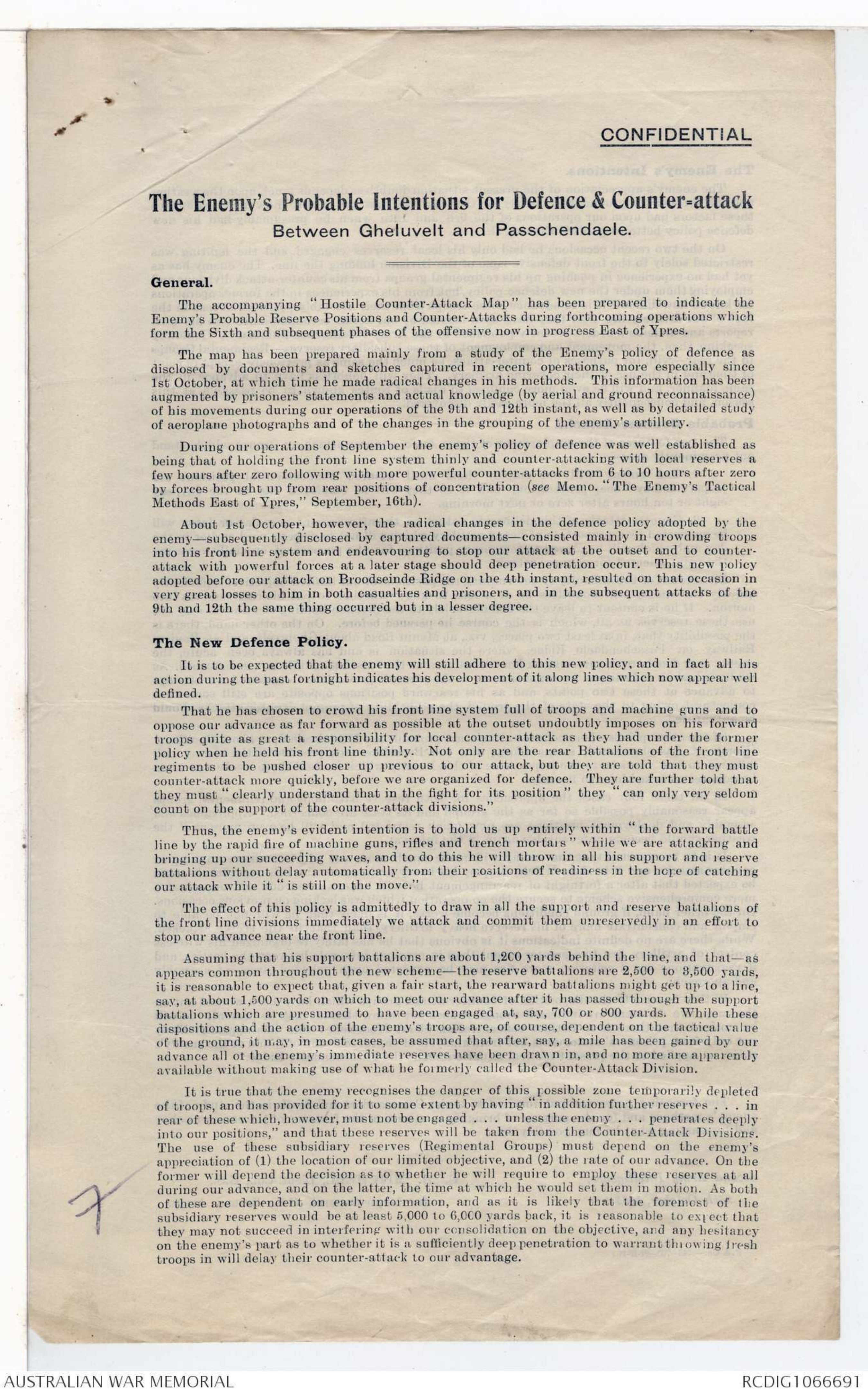
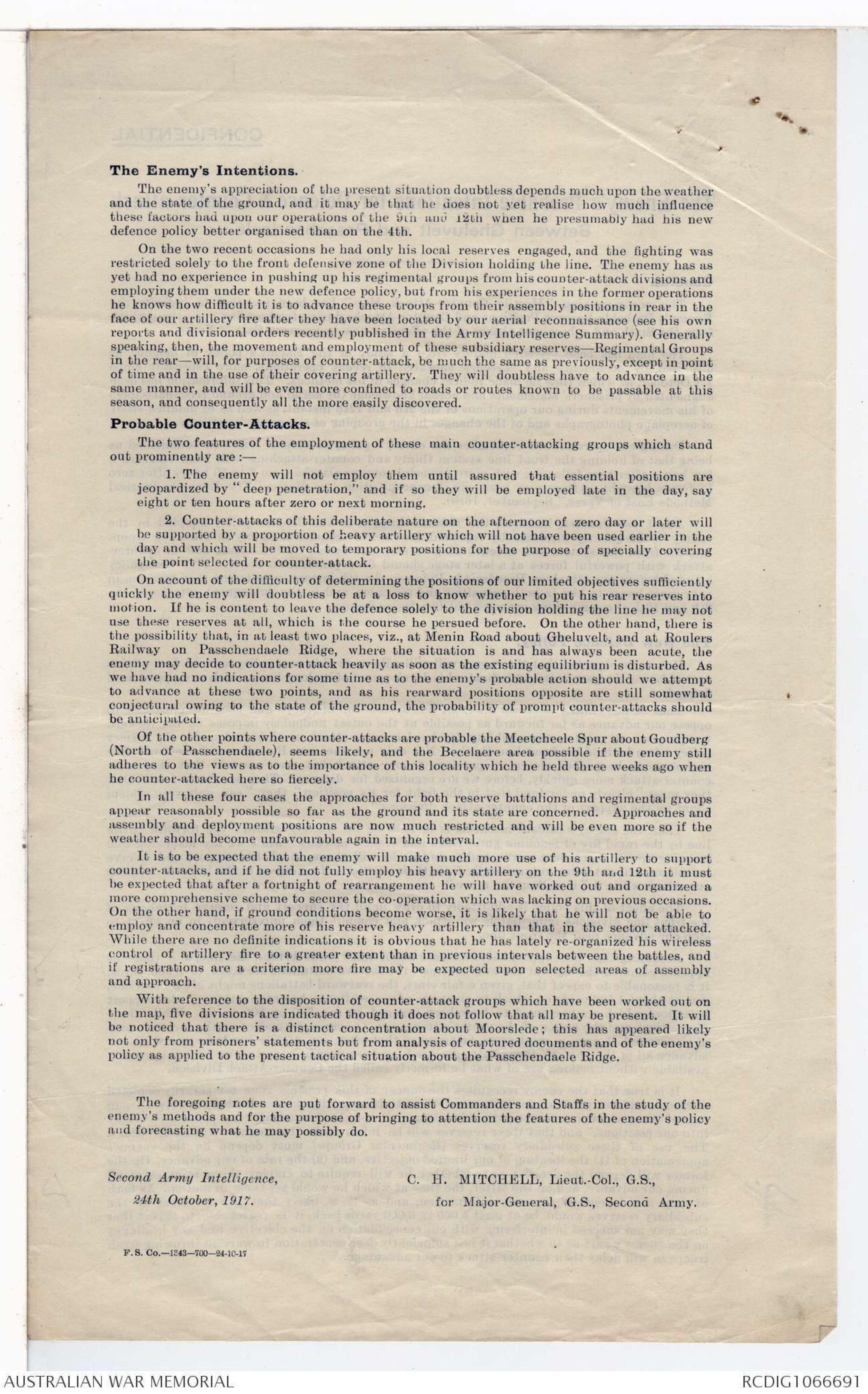
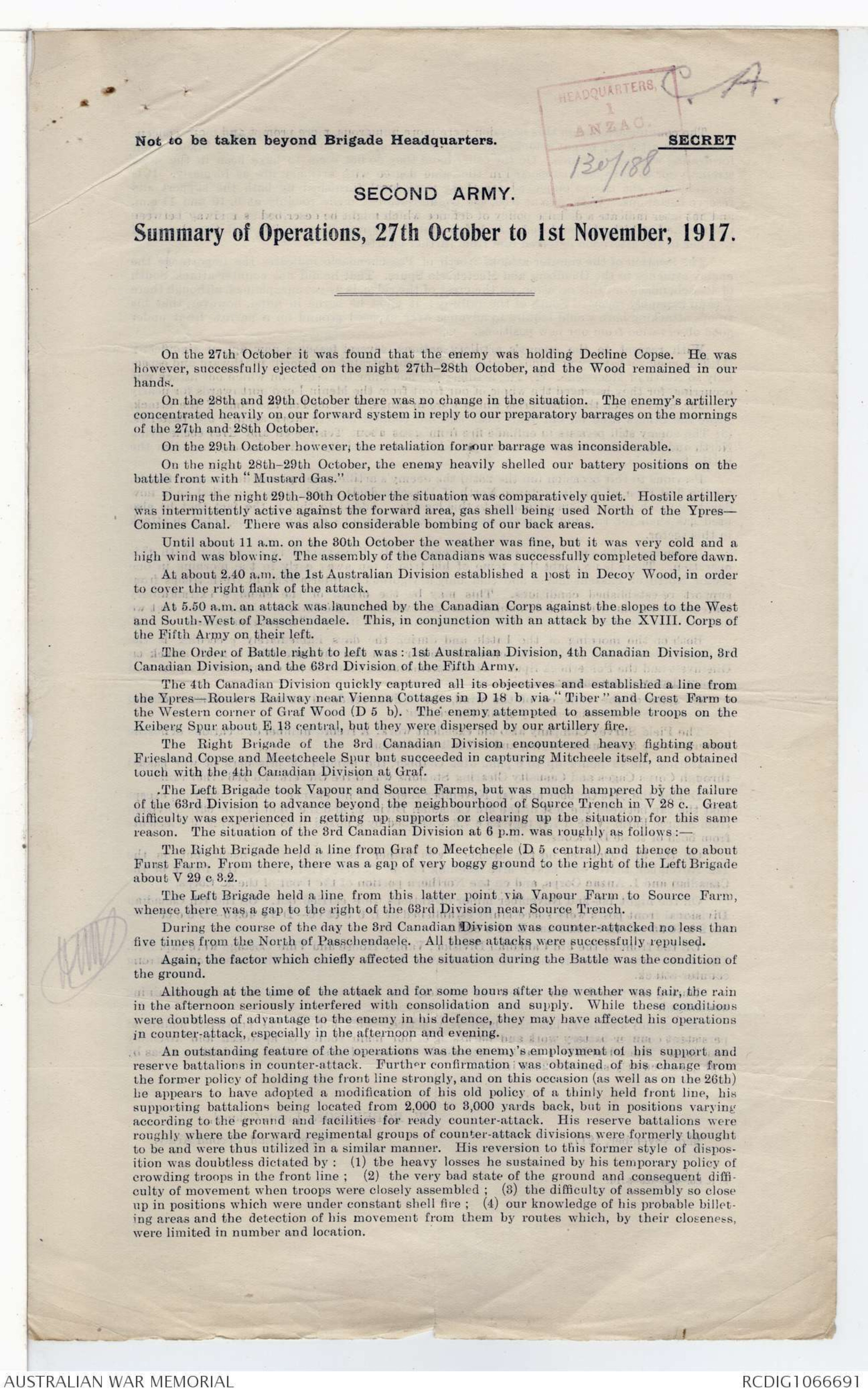
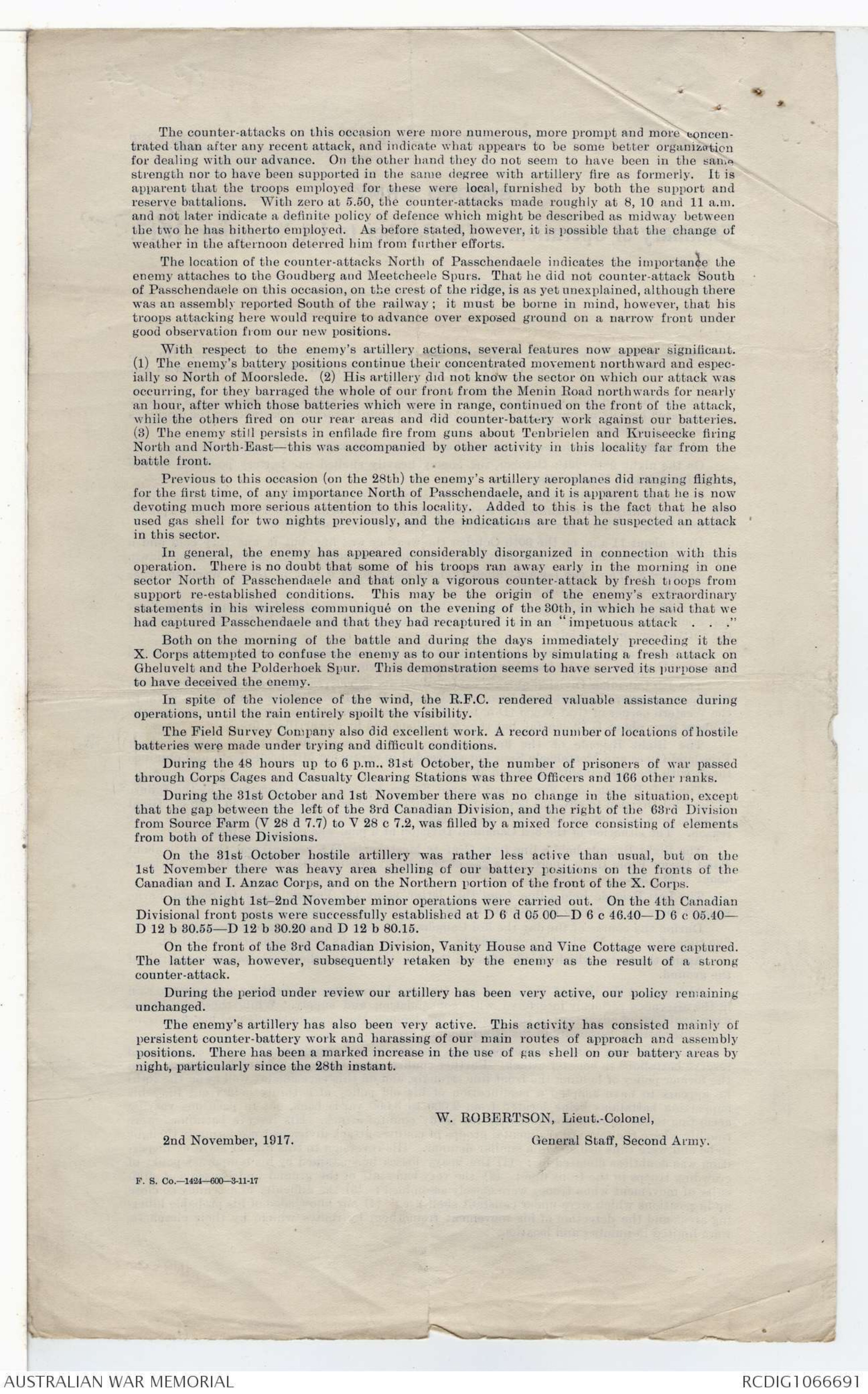
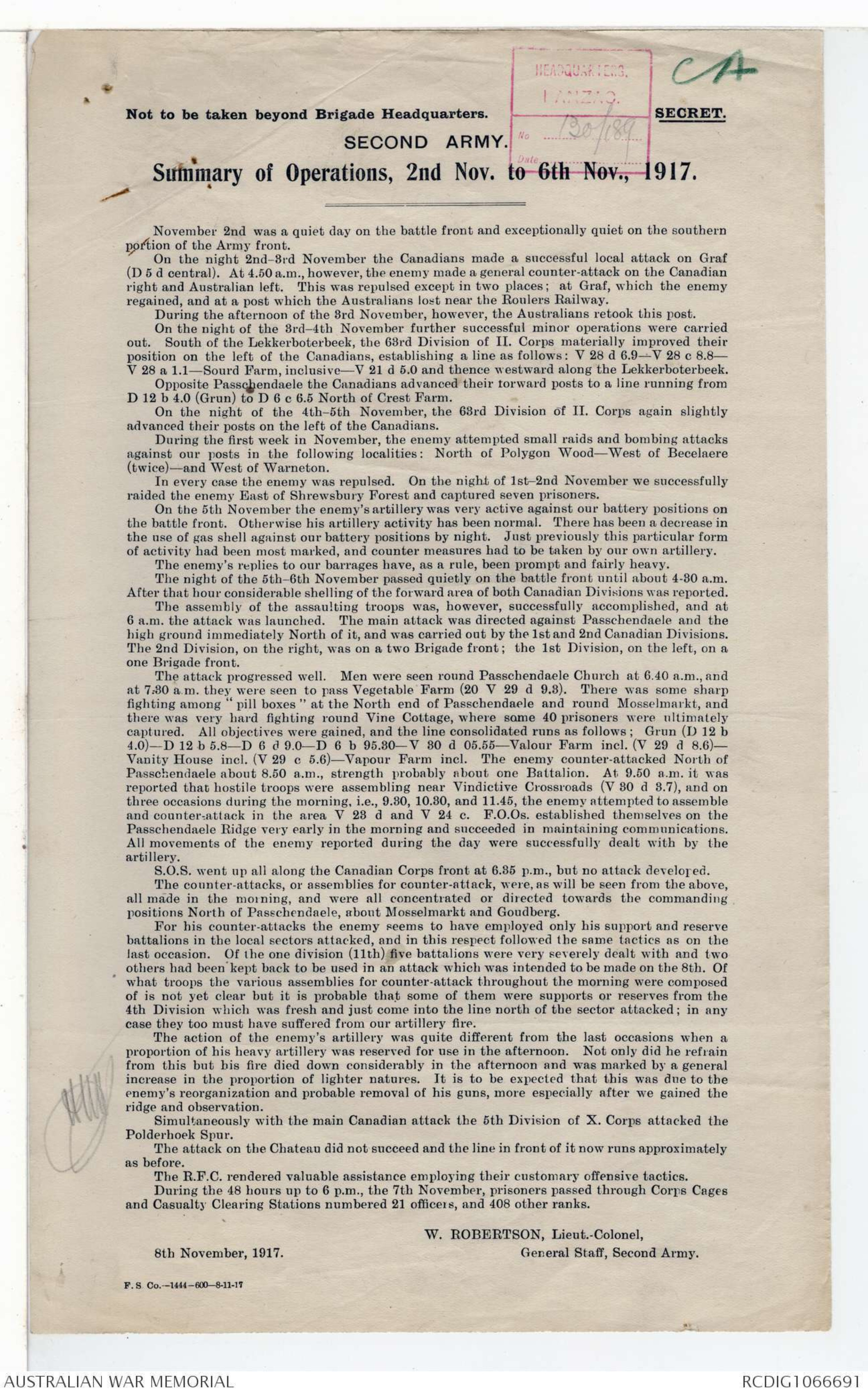
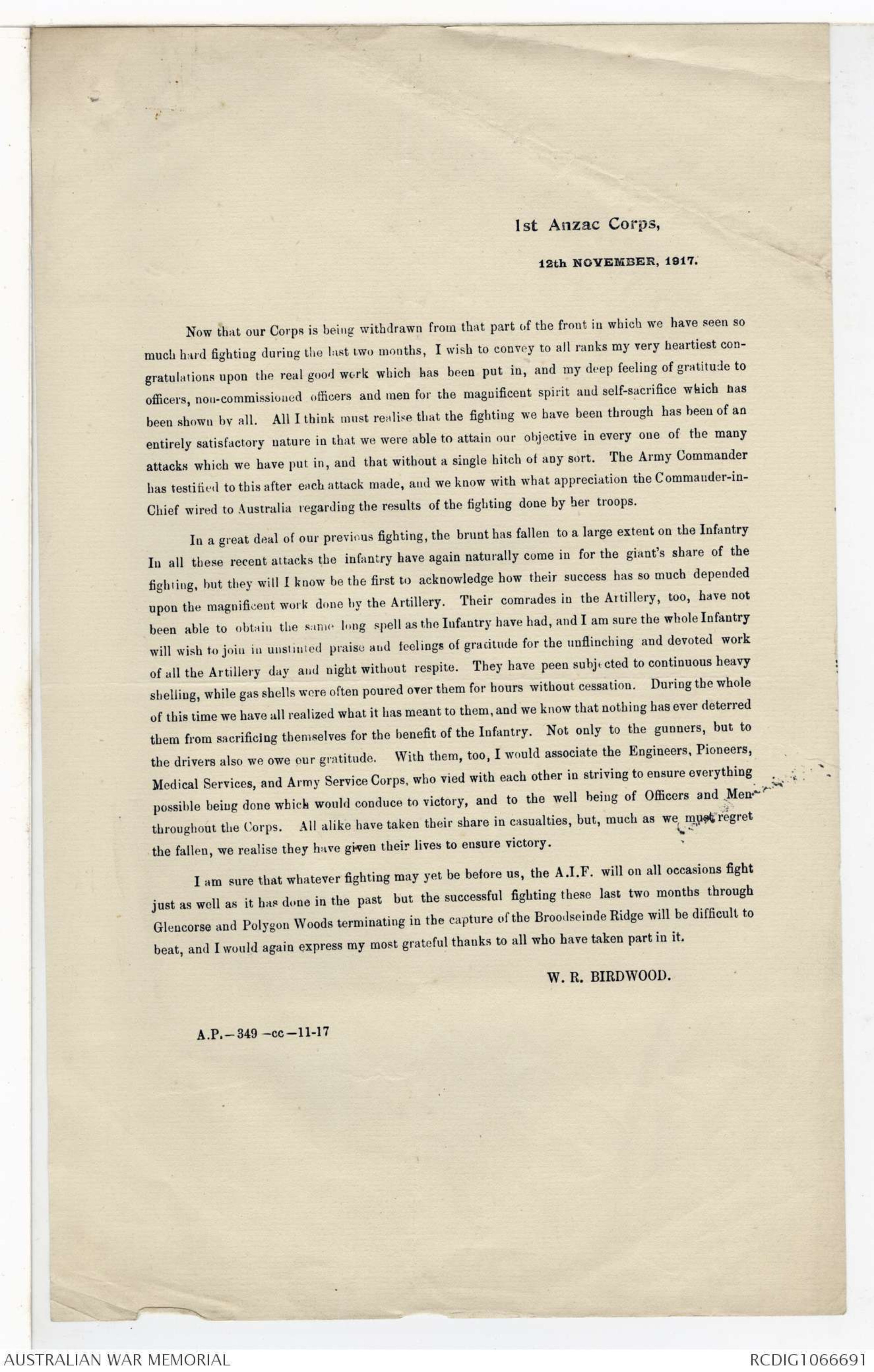

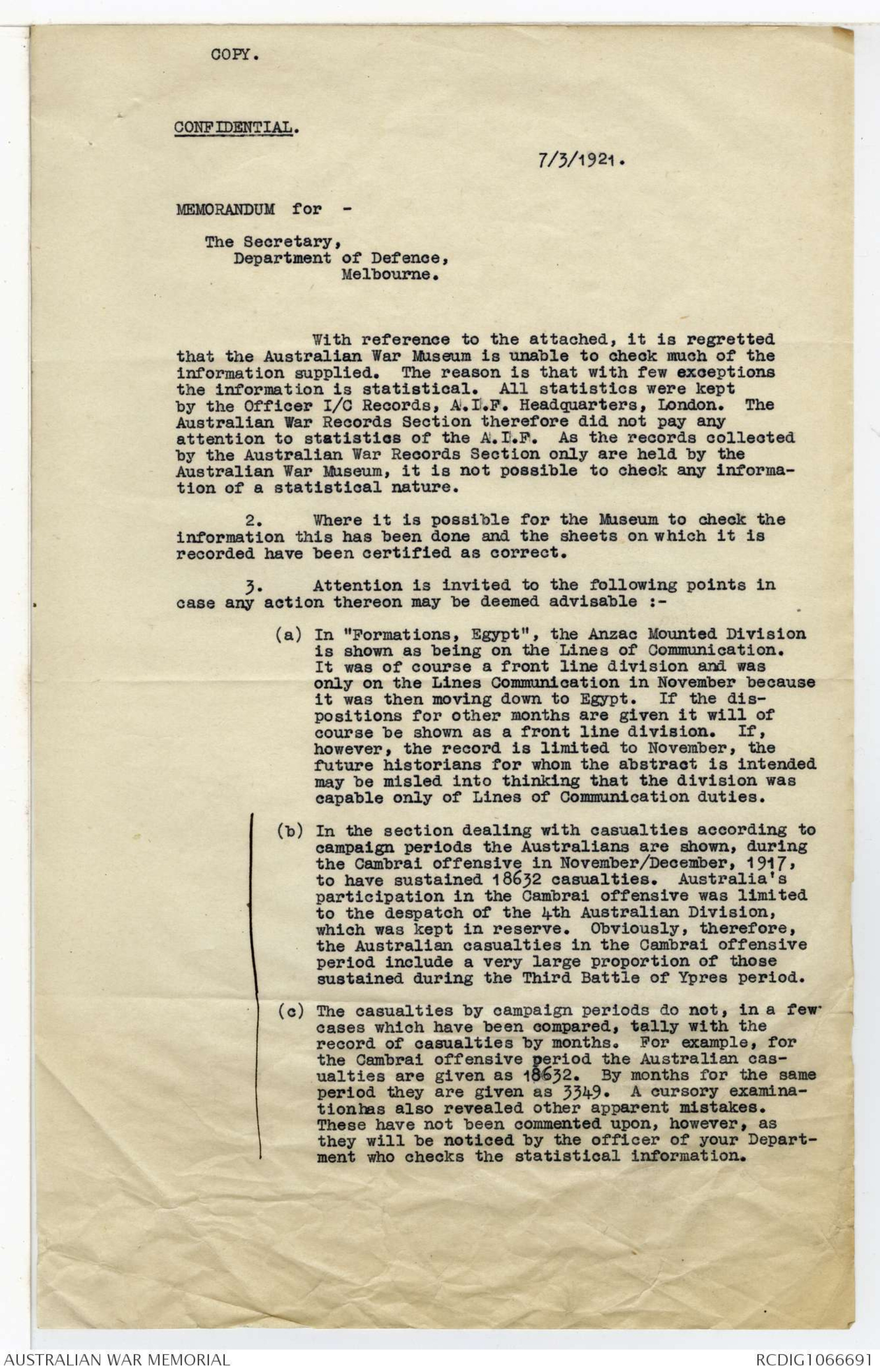
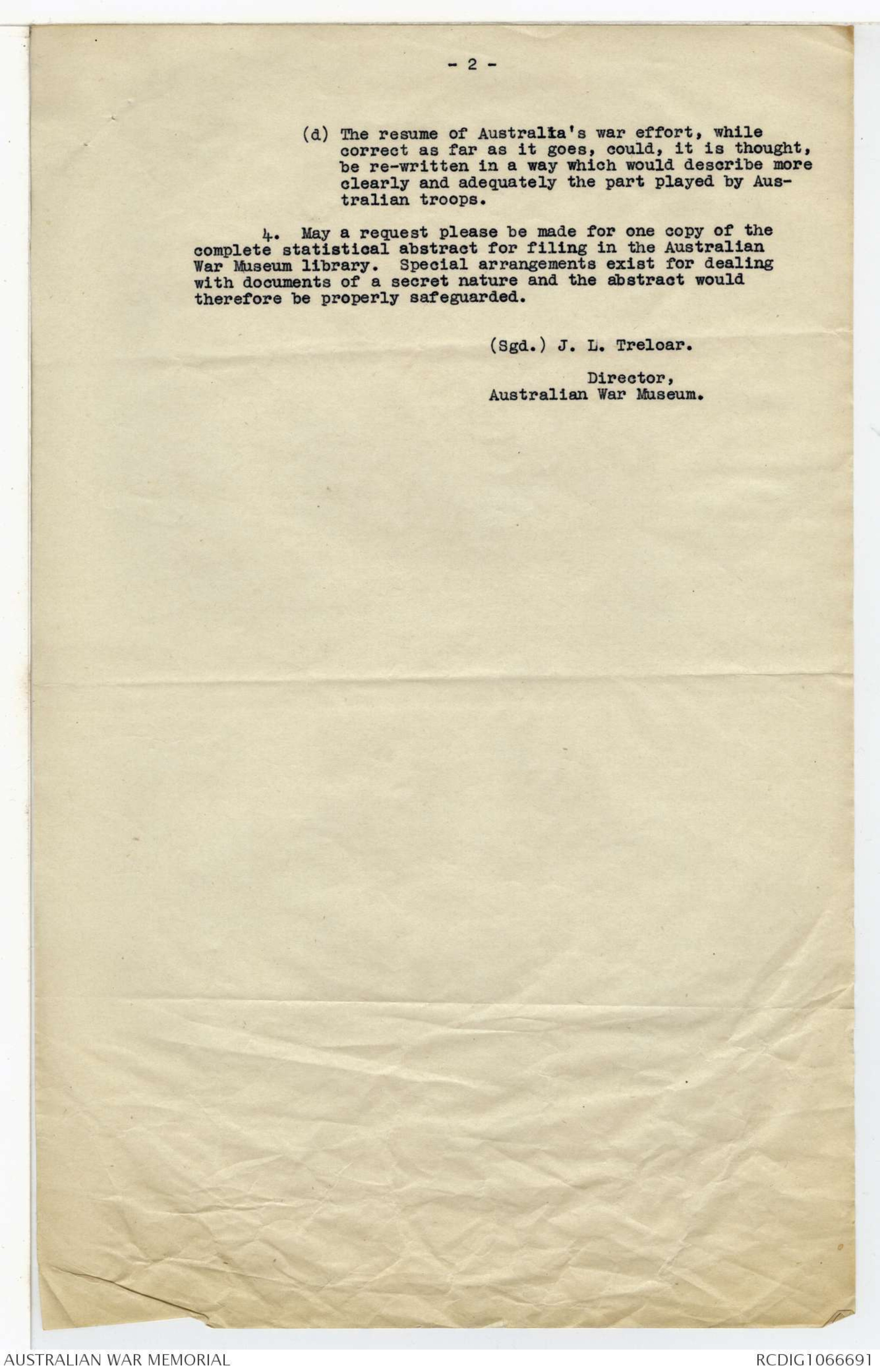

CONFIDENTIAL
The Enemy's Probable Intentions for Defence & Counter-attack
Between Gheluvelt and Passchendaele.
General.
The accompanying "Hostile Counter-Attack Map” has been prepared to indicate the
Enemy's Probable Reserve Positions and Counter-Attacks during forthcoming operations which
form the Sixth and subsequent phases of the offensive now in progress East of Ypres.
The map has been prepared mainly from a study of the Enemy's policy of defence as
disclosed by documents and sketches captured in recent operations, more especially since
1st October, at which time he made radical changes in his methods. This information has been
augmented by prisoners' statements and actual knowledge (by aerial and ground reconnaissance)
of his movements during our operations of the 9th and 12th instant, as well as by detailed study
of aeroplane photographs and of the changes in the grouping of the enemy's artillery.
During our operations of September the enemy's policy of defence was well established as
being that of holding the front line system thinly and counter-attacking with local reserves a
few hours after zero following with more powerful counter-attacks from 6 to 10 hours after zero
by forces brought up from rear positions of concentration (see Memo. “The Enemy's Tactical
Methods East of Ypres," September, 16th).
About 1st October, however, the radical changes in the defence policy adopted by the
enemy—subsequently disclosed by captured documents—consisted mainly in crowding troops
into his front line system and endeavouring to stop our attack at the outset and to counter-attack
with powerful forces at a later stage should deep penetration occur. This new policy
adopted before our attack on Broodseinde Ridge on the 4th instant, resulted on that occasion in
very great losses to him in both casualties and prisoners, and in the subsequent attacks of the
9th and 12th the same thing occurred but in a lesser degree.
The New Defence Policy.
It is to be expected that the enemy will still adhere to this new policy, and in fact all his
action during the past fortnight indicates his development of it along lines which now appear well
defined.
That he has chosen to crowd his front line system full of troops and machine guns and to
oppose our advance as far forward as possible at the outset undoubtly imposes on his forward
troops quite as great a responsibility for local counter-attack as they had under the former
policy when he held his front line thinly. Not only are the rear Battalions of the front line
regiments to be pushed closer up previous to our attack, but they are told that they must
counter-attack more quickly, before we are organized for defence. They are further told that
they must "clearly understand that in the fight for its position" they "can only very seldom
count on the support of the counter-attack divisions."
Thus, the enemy's evident intention is to hold us up entirely within "the forward battle
line by the rapid fire of machine guns, rifles and trench mortars" while we are attacking and
bringing up our succeeding waves, and to do this he will throw in all his support and reserve
battalions without delay automatically from their positions of readiness in the hope of catching
our attack while it "is still on the move."
The effect of this policy is admittedly to draw in all the support and reserve battalions
of the front line divisions immediately we attack and commit them unreservedly in an effort to
stop our advance near the front line.
Assuming that his support battalions are about 1,200 yards behind the line, and that—as
appears common throughout the new scheme—the reserve battalions are 2,500 to 3,500 yards,
it is reasonable to expect that, given a fair start, the rearward battalions might get up to a line,
say, at about 1,500 yards on which to meet our advance after it has passed through the support
battalions which are presumed to have been engaged at, say, 700 or 800 yards. While these
dispositions and the action of the enemy's troops are, of course, dependent on the tactical value
of the ground, it may, in most cases, be assumed that after, say, a mile has been gained by our
advance all of the enemy's immediate reserves have been drawn in, and no more are apparently
available without making use of what he formerly called the Counter-Attack Division.
It is true that the enemy recognises the danger of this possible zone temporarily depleted
of troops, and has provided for it to some extent by having "in addition further reserves . . . in
rear of these which, however, must not be engaged . . . unless the enemy . . . penetrates deeply
into our positions," and that these reserves will be taken from the Counter-Attack Divisions.
The use of these subsidiary reserves (Regimental Groups) must depend on the enemy's
appreciation of (1) the location of our limited objective, and (2) the rate of our advance. On the
former will depend the decision as to whether he will require to employ these reserves at all
during our advance, and on the latter, the time at which he would set them in motion. As both
of these are dependent on early information, and as it is likely that the foremost of the
subsidiary reserves would be at least 5,000 to 6,000 yards back, it is reasonable to expect that
they may not succeed in interfering with our consolidation on the objective, and any hesitancy
on the enemy's part as to whether it is a sufficiently deep penetration to warrant throwing fresh
troops in will delay their counter-attack to our advantage.
The Enemy's Intentions.
The enemy's appreciation of the present situation doubtless depends much upon the weather
and the state of the ground, and it may be that he does not yet realise how much influence
these factors had upon our operations of the 9th and 12th when he presumably had his new
defence policy better organised than on the 4th.
On the two recent occasions he had only his local reserves engaged, and the fighting was
restricted solely to the front defensive zone of the Division holding the line. The enemy has as
yet had no experience in pushing up his regimental groups from his counter-attack divisions and
employing them under the new defence policy, but from his experiences in the former operations
he knows how difficult it is to advance these troops from their assembly positions in rear in the
face of our artillery fire after they have been located by our aerial reconnaissance (see his own
reports and divisional orders recently published in the Army Intelligence Summary). Generally
speaking, then, the movement and employment of these subsidiary reserves—Regimental Groups
in the rear—will, for purposes of counter-attack, be much the same as previously, except in point
of time and in the use of their covering artillery. They will doubtless have to advance in the
same manner, and will be even more confined to roads or routes known to be passable at this
season, and consequently all the more easily discovered.
Probable Counter-Attacks.
The two features of the employment of these main counter-attacking groups which stand
out prominently are:—
1. The enemy will not employ them until assured that essential positions are
jeopardized by "deep penetration," and if so they will be employed late in the day, say
eight or ten hours after zero or next morning.
2. Counter-attacks of this deliberate nature on the afternoon of zero day or later will
be supported by a proportion of heavy artillery which will not have been used earlier in the
day and which will be moved to temporary positions for the purpose of specially covering
the point selected for counter-attack.
On account of the difficulty of determining the positions of our limited objectives sufficiently
quickly the enemy will doubtless be at a loss to know whether to put his rear reserves into
motion. If he is content to leave the defence solely to the division holding the line he may not
use these reserves at all, which is the course he persued before. On the other hand, there is
the possibility that, in at least two places, viz., at Menin Road about Gheluvelt, and at Roulers
Railway on Passchendaele Ridge, where the situation is and has always been acute, the
enemy may decide to counter-attack heavily as soon as the existing equilibrium is disturbed. As
we have had no indications for some time as to the enemy's probable action should we attempt
to advance at these two points, and as his rearward positions opposite are still somewhat
conjectural owing to the state of the ground, the probability of prompt counter-attacks should
be anticipated.
Of the other points where counter-attacks are probable the Meetcheele Spur about Goudberg
(North of Passchendaele), seems likely, and the Becelaere area possible if the enemy still
adheres to the views as to the importance of this locality which he held three weeks ago when
he counter-attacked here so fiercely.
In all these four cases the approaches for both reserve battalions and regimental groups
appear reasonably possible so far as the ground and its state are concerned. Approaches and
assembly and deployment positions are now much restricted and will be even more so if the
weather should become unfavourable again in the interval.
It is to be expected that the enemy will make much more use of his artillery to support
counter-attacks, and if he did not fully employ his heavy artillery on the 9th and 12th it must
be expected that after a fortnight of rearrangement he will have worked out and organized a
more comprehensive scheme to secure the co-operation which was lacking on previous occasions.
On the other hand, if ground conditions become worse, it is likely that he will not be able to
employ and concentrate more of his reserve heavy artillery than that in the sector attacked.
While there are no definite indications it is obvious that he has lately re-organized his wireless
control of artillery fire to a greater extent than in previous intervals between the battles, and
if registrations are a criterion more fire may be expected upon selected areas of assembly
and approach.
With reference to the disposition of counter-attack groups which have been worked out on
the map, five divisions are indicated though it does not follow that all may be present. It will
be noticed that there is a distinct concentration about Moorslede; this has appeared likely
not only from prisoners' statements but from analysis of captured documents and of the enemy's
policy as applied to the present tactical situation about the Passchendaele Ridge.
The foregoing notes are put forward to assist Commanders and Staffs in the study of the
enemy's methods and for the purpose of bringing to attention the features of the enemy's policy
and forecasting what he may possibly do.
Second Army Intelligence, C. H. MITCHELL, Lieut.-Col., G.S.,
24th October, 1917. for Major-General, G.S., Second Army.
F.S. Co.—1243—700—24-10-17
[*C.A.*]
[*HEADQUARTERS,
1
ANZAC.*]
Not to be taken beyond Brigade Headquarters. SECRET
[*130/188*]
SECOND ARMY.
Summary of Operations, 27th October to 1st November, 1917.
On the 27th October it was found that the enemy was holding Decline Copse. He was
however, successfully ejected on the night 27th-28th October, and the Wood remained in our
hands.
On the 28th and 29th October there was no change in the situation. The enemy's artillery
concentrated heavily on our forward system in reply to our preparatory barrages on the mornings
of the 27th and 28th October.
On the 29th October however, the retaliation for our barrage was inconsiderable.
On the night 28th-29th October, the enemy heavily shelled our battery positions on the
battle front with "Mustard Gas."
During the night 29th-30th October the situation was comparatively quiet. Hostile artillery
was intermittently active against the forward area, gas shell being used North of the Ypres—
Comines Canal. There was also considerable bombing of our back areas.
Until about 11 a.m. on the 30th October the weather was fine, but it was very cold and a
high wind was blowing. The assembly of the Canadians was successfully completed before dawn.
At about 2.40 a.m. the 1st Australian Division established a post in Decoy Wood, in order
to cover the right flank of the attack.
At 5.50 a.m. an attack was launched by the Canadian Corps against the slopes to the West
and South-West of Passchendaele. This, in conjunction with an attack by the XVIII. Corps of
the Fifth Army on their left.
The Order of Battle right to left was: 1st Australian Division, 4th Canadian Division, 3rd
Canadian Division, and the 63rd Division of the Fifth Army.
The 4th Canadian Division quickly captured all its objectives and established a line from
the Ypres—Roulers Railway near Vienna Cottages in D 18 b via "Tiber" and Crest Farm to
the Western corner of Graf Wood (D 5 b). The enemy attempted to assemble troops on the
Keiberg Spur about E 13 central, but they were dispersed by our artillery fire.
The Right Brigade of the 3rd Canadian Division encountered heavy fighting about
Friesland Copse and Meetcheele Spur but succeeded in capturing Mitcheele itself, and obtained
touch with the 4th Canadian Division at Graf.
.The Left Brigade took Vapour and Source Farms, but was much hampered by the failure
of the 63rd Division to advance beyond the neighbourhood of Source Trench in V 28 c. Great
difficulty was experienced in getting up supports or clearing up the situation for this same
reason. The situation of the 3rd Canadian Division at 6 p.m. was roughly as follows:—
The Right Brigade held a line from Graf to Meetcheele (D 5 central) and thence to about
Furst Farm. From there, there was a gap of very boggy ground to the right of the Left Brigade
about V 29 c 3.2.
The Left Brigade held a line from this latter point via Vapour Farm, to Source Farm,
whence there was a gap to the right of the 63rd Division near Source Trench.
[*HM*] During the course of the day the 3rd Canadian Division was counter-attacked no less than
five times from the North of Passchendaele. All these attacks were successfully repulsed.
Again, the factor which chiefly affected the situation during the Battle was the condition of
the ground.
Although at the time of the attack and for some hours after the weather was fair, the rain
in the afternoon seriously interfered with consolidation and supply. While these conditions
were doubtless of advantage to the enemy in his defence, they may have affected his operations
in counter-attack, especially in the afternoon and evening.
An outstanding feature of the operations was the enemy's employment of his support and
reserve battalions in counter-attack. Further confirmation was obtained of his change from
the former policy of holding the front line strongly, and on this occasion (as well as on the 26th)
he appears to have adopted a modification of his old policy of a thinly held front line, his
supporting battalions being located from 2,000 to 3,000 yards back, but in positions varying
according to the ground and facilities for ready counter-attack. His reserve battalions were
roughly where the forward regimental groups of counter-attack divisions were formerly thought
to be and were thus utilized in a similar manner. His reversion to this former style of disposition
was doubtless dictated by : (1) the heavy losses he sustained by his temporary policy of
crowding troops in the front line ; (2) the very bad state of the ground and consequent
difficulty of movement when troops were closely assembled ; (3) the difficulty of assembly so close
up in positions which were under constant shell fire ; (4) our knowledge of his probable billeting
areas and the detection of his movement from them by routes which, by their closeness,
were limited in number and location.
The counter-attacks on this occasion were more numerous, more prompt and more concentrated than after any recent attack, and indicate what appears to be some better organization
for dealing with our advance. On the other hand they do not seem to have been in the same
strength nor to have been supported in the same degree with artillery fire as formerly. It is
apparent that the troops employed for these were local, furnished by both the support and
reserve battalions. With zero at 5.50, the counter-attacks made roughly at 8, 10 and 11 a.m.
and not later indicate a definite policy of defence which might be described as midway between
the two he has hitherto employed. As before stated, however, it is possible that the change of
weather in the afternoon deterred him from further efforts.
The location of the counter-attacks North of Passchendaele indicates the importance the
enemy attaches to the Goudberg and Meetcheele Spurs. That he did not counter-attack South
of Passchendaele on this occasion, on the crest of the ridge, is as yet unexplained, although there
was an assembly reported South of the railway ; it must be borne in mind, however, that his
troops attacking here would require to advance over exposed ground on a narrow front under
good observation from our new positions.
With respect to the enemy's artillery actions, several features now appear significant.
(1) The enemy's battery positions continue their concentrated movement northward and especially
so North of Moorslede. (2) His artillery did not know the sector on which our attack was
occurring, for they barraged the whole of our front from the Menin Road northwards for nearly
an hour, after which those batteries which were in range, continued on the front of the attack,
while the others fired on our rear areas and did counter-battery work against our batteries.
(3) The enemy still persists in enfilade fire from guns about Tenbrielen and Kruiseecke firing
North and North-East—this was accompanied by other activity in this locality far from the
battle front.
Previous to this occasion (on the 28th) the enemy's artillery aeroplanes did ranging flights,
for the first time, of any importance North of Passchendaele, and it is apparent that he is now
devoting much more serious attention to this locality. Added to this is the fact that he also
used gas shell for two nights previously, and the indications are that he suspected an attack
in this sector.
In general, the enemy has appeared considerably disorganized in connection with this
operation. There is no doubt that some of his troops ran away early in the morning in one
sector North of Passchendaele and that only a vigorous counter-attack by fresh troops from
support re-established conditions. This may be the origin of the enemy's extraordinary
statements in his wireless communiqué on the evening of the 30th, in which he said that we
had captured Passchendaele and that they had recaptured it in an "impetuous attack . . ."
Both on the morning of the battle and during the days immediately preceding it the
X. Corps attempted to confuse the enemy as to our intentions by simulating a fresh attack on Gheluvelt and the Polderhoek Spur. This demonstration seems to have served its purpose and
to have deceived the enemy.
In spite of the violence of the wind, the R.F.C. rendered valuable assistance during
operations, until the rain entirely spoilt the visibility.
The Field Survey Company also did excellent work. A record number of locations of hostile
batteries were made under trying and difficult conditions.
During the 48 hours up to 6 p.m., 31st October, the number of prisoners of war passed
through Corps Cages and Casualty Clearing Stations was three Officers and 166 other ranks.
During the 31st October and 1st November there was no change in the situation, except
that the gap between the left of the 3rd Canadian Division, and the right of the 63rd Division
from Source Farm (V 28 d 7.7) to V 28 c 7.2, was filled by a mixed force consisting of elements
from both of these Divisions.
On the 31st October hostile artillery was rather less active than usual, but on the
1st November there was heavy area shelling of our battery positions on the fronts of the
Canadian and I. Anzac Corps, and on the Northern portion of the front of the X. Corps.
On the night 1st-2nd November minor operations were carried out. On the 4th Canadian
Divisional front posts were successfully established at D 6 d 05 00—D 6 c 46.40—D 6 c 05.40—
D 12 b 30.55—D 12 b 30.20 and D 12 b 80.15.
On the front of the 3rd Canadian Division, Vanity House and Vine Cottage were captured.
The latter was, however, subsequently retaken by the enemy as the result of a strong
counter-attack.
During the period under review our artillery has been very active, our policy remaining
unchanged.
The enemy's artillery has also been very active. This activity has consisted mainly of
persistent counter-battery work and harassing of our main routes of approach and assembly
positions. There has been a marked increase in the use of gas shell on our battery areas by
night, particularly since the 28th instant.
W. ROBERTSON, Lieut.-Colonel,
2nd November, 1917. General Staff, Second Army.
F. S. Co.—1424—600—3-11-17
[*HEADQUARTERS.*] [*CA*]
[*I ANZAC.*]
Not to be taken beyond Brigade Headquarters. SECRET.
[*No 130/189*]
SECOND ARMY.
[*Date.........*]
Summary of Operations, 2nd Nov. to 6th Nov., 1917.
November 2nd was a quiet day on the battle front and exceptionally quiet on the southern
portion of the Army front.
On the night 2nd-3rd November the Canadians made a successful local attack on Graf
(D 5 d central). At 4.50 a.m., however, the enemy made a general counter-attack on the Canadian
right and Australian left. This was repulsed except in two places; at Graf, which the enemy
regained, and at a post which the Australians lost near the Roulers Railway.
During the afternoon of the 3rd November, however, the Australians retook this post.
On the night of the 3rd-4th November further successful minor operations were carried
out. South of the Lekkerboterbeek, the 63rd Division of II. Corps materially improved their
position on the left of the Canadians, establishing a line as follows: V 28 d 6.9—V 28 c 8.8—
V 28 a 1.1—Sourd Farm, inclusive—V 21 d 5.0 and thence westward along the Lekkerboterbeek. Opposite Passchendaele the Canadians advanced their forward posts to a line running from
D 12 b 4.0 (Grun) to D 6 c 6.5 North of Crest Farm.
On the night of the 4th-5th November, the 63rd Division of II. Corps again slightly
advanced their posts on the left of the Canadians.
During the first week in November, the enemy attempted small raids and bombing attacks
against our posts in the following localities: North of Polygon Wood—West of Becelaere
(twice)—and West of Warneton.
In every case the enemy was repulsed. On the night of 1st-2nd November we successfully
raided the enemy East of Shrewsbury Forest and captured seven prisoners.
On the 5th November the enemy's artillery was very active against our battery positions on
the battle front. Otherwise his artillery activity has been normal. There has been a decrease in
the use of gas shell against our battery positions by night. Just previously this particular form
of activity had been most marked, and counter measures had to be taken by our own artillery.
The enemy's replies to our barrages have, as a rule, been prompt and fairly heavy.
The night of the 5th-6th November passed quietly on the battle front until about 4-30 a.m.
After that hour considerable shelling of the forward area of both Canadian Divisions was reported.
The assembly of the assaulting troops was, however, successfully accomplished, and at
6 a.m. the attack was launched. The main attack was directed against Passchendaele and the
high ground immediately North of it, and was carried out by the 1st and 2nd Canadian Divisions.
The 2nd Division, on the right, was on a two Brigade front; the 1st Division, on the left, on a
one Brigade front.
The attack progressed well. Men were seen round Passchendaele Church at 6.40 a.m., and
at 7.30 a.m. they were seen to pass Vegetable Farm (20 V 29 d 9.3). There was some sharp
fighting among "pill boxes" at the North end of Passchendaele and round Mosselmarkt, and
there was very hard fighting round Vine Cottage, where some 40 prisoners were ultimately
captured. All objectives were gained, and the line consolidated runs as follows; Grun (D 12 b
4.0)—D 12 b 5.8—D 6 d 9.0—D 6 b 95.30—V 30 d 05.55—Valour Farm incl. (V 29 d 8.6)—
Vanity House incl. (V 29 c 5.6)—Vapour Farm incl. The enemy counter-attacked North of
Passchendaele about 8.50 a.m., strength probably about one Battalion. At 9.50 a.m. it was
reported that hostile troops were assembling near Vindictive Crossroads (V 30 d 3.7), and on
three occasions during the morning, i.e., 9.30, 10.30, and 11.45, the enemy attempted to assemble
and counter-attack in the area V 23 d and V 24 c. F.O.Os. established themselves on the
Passchendaele Ridge very early in the morning and succeeded in maintaining communications.
All movements of the enemy reported during the day were successfully dealt with by the
artillery.
S.O.S. went up all along the Canadian Corps front at 6.35 p.m., but no attack developed.
The counter-attacks, or assemblies for counter-attack, were, as will be seen from the above,
all made in the morning, and were all concentrated or directed towards the commanding
positions North of Passchendaele, about Mosselmarkt and Goudberg.
For his counter-attacks the enemy seems to have employed only his support and reserve
battalions in the local sectors attacked, and in this respect followed the same tactics as on the
last occasion. Of the one division (11th) five battalions were very severely dealt with and two
others had been kept back to be used in an attack which was intended to be made on the 8th. Of
what troops the various assemblies for counter-attack throughout the morning were composed
of is not yet clear but it is probable that some of them were supports or reserves from the
4th Division which was fresh and just come into the line north of the sector attacked; in any
case they too must have suffered from our artillery fire.
The action of the enemy's artillery was quite different from the last occasions when a
proportion of his heavy artillery was reserved for use in the afternoon. Not only did he refrain
from this but his fire died down considerably in the afternoon and was marked by a general
increase in the proportion of lighter natures. It is to be expected that this was due to the
[*HM*] enemy's reorganizaton and probable removal of his guns, more especially after we gained the
ridge and observation.
Simultaneously with the main Canadian attack the 5th Division of X. Corps attacked the
Polderhoek Spur.
The attack on the Chateau did not succeed and the line in front of it now runs approximately
as before.
The R.F.C. rendered valuable assistance employing their customary offensive tactics.
During the 48 hours up to 6 p.m., the 7th November, prisoners passed through Corps Cages
and Casualty Clearing Stations numbered 21 officers, and 408 other ranks.
W. ROBERTSON, Lieut.-Colonel,
8th November, 1917. General Staff, Second Army.
F.S Co.—1444—600—8-11-17
1st Anzac Corps,
12th NOVEMBER, 1917.
Now that our Corps is being withdrawn from that part of the front in which we have seen so
much hard fighting during the last two months, I wish to convey to all ranks my very heartiest congratulations upon the real good work which has been put in, and my deep feeling of gratitude to
officers, non-commissioned officers and men for the magnificent spirit and self-sacrifice which has
been shown by all. All I think must realise that the fighting we have been through has been of an
entirely satisfactory nature in that we were able to attain our objective in every one of the many
attacks which we have put in, and that without a single hitch of any sort. The Army Commander
has testified to this after each attack made, and we know with what appreciation the Commander-in-Chief wired to Australia regarding the results of the fighting done by her troops.
In a great deal of our previous fighting, the brunt has fallen to a large extent on the Infantry
In all these recent attacks the infantry have again naturally come in for the giant's share of the
fighting, but they will I know be the first to acknowledge how their success has so much depended
upon the magnificent work done by the Artillery. Their comrades in the Artillery, too, have not
been able to obtain the same long spell as the Infantry have had, and I am sure the whole Infantry
will wish to join in unstinted praise and feelings of gratitude for the unflinching and devoted work
of all the Artillery day and night without respite. They have peen subjected to continuous heavy
shelling, while gas shells were often poured over them for hours without cessation. During the whole
of this time we have all realized what it has meant to them, and we know that nothing has ever deterred
them from sacrificing themselves for the benefit of the Infantry. Not only to the gunners, but to
the drivers also we owe our gratitude. With them, too, I would associate the Engineers, Pioneers,
Medical Services, and Army Service Corps, who vied with each other in striving to ensure everything
possible being done which would conduce to victory, and to the well being of Officers and Men
throughout the Corps. All alike have taken their share in casualties, but, much as we must regret
the fallen, we realise they have given their lives to ensure victory.
I am sure that whatever fighting may yet be before us, the A.I.F. will on all occasions fight
just as well as it has done in the past but the successful fighting these last two months through
Glencorse and Polygon Woods terminating in the capture of the Broodseinde Ridge will be difficult to
beat, and I would again express my most grateful thanks to all who have taken part in it.
W. R. BIRDWOOD.
A.P.—349—cc—11-17
TELEPHONE Nos. COMMONWEALTH OF AUSTRALIA. TELEGRAPHIC ADDRESS
F 2597. "AUSWARMUSE."
F 2598.
COMMUNICATIONS TO BE ADDRESSED TO
"THE DIRECTOR."
AUSTRALIAN WAR MEMORIAL
IN REPLY PLEASE QUOTE
NO 12/3/49
"They gave their lives. For that public gift they
received a praise which never ages and a POST OFFICE BOX 214 D.
tomb most glorious—not so much the tomb in EXHIBITION BUILDINGS, MELBOURNE
which they lie, but that in which their fame
survives, to be remembered for ever when occasion
comes for word or deed . . . . . "
2nd March, 1933.
Dear Mr. Bazley,
Major Treloar has written to me in regard
to the Australian casualties during the Third Battle of
Ypres. He has suggested that perhaps a the discrepancy in
the British and Australian figures may be explained by
the possibility of the British authorities having allocated
the Australian casualties during the latter stages of the
Ypres operations to the Battle of Cambrai and in this
connection he has asked me to forward to you a copy of
the comments on this particular error made when the draft
of the British statistical abstract was submitted to us
in 1921. A copy of this letter is enclosed.
Major Treloar considers there is little
we can do to help solve the discrepancy until enquiries
which Dr. Bean has instituted are completed. We are,
however, combing our records and in the event of our
discovering any information likely to be of assistance
will immediately bring it to your notice.
Yours sincerely,
TH Heyes
Mr. A. W. Bazley,
C/- Official Historian,
Victoria Barracks,
Paddington, N.S.W.
COPY.
CONFIDENTIAL.
7/3/1921.
MEMORANDUM for –
The Secretary,
Department of Defence,
Melbourne.
With reference to the attached, it is regretted
that the Australian War Museum is unable to check much of the
information supplied. The reason is that with few exceptions
the information is statistical. All statistics were kept
by the Officer I/C Records, A.I.F. Headquarters, London. The
Australian War Records Section therefore did not pay any
attention to statistics of the A.I.F. As the records collected
by the Australian War Records Section only are held by the
Australian War Museum, it is not possible to check any information
of a statistical nature.
2. Where it is possible for the Museum to check the
information this has been done and the sheets on which it is
recorded have been certified as correct.
3. Attention is invited to the following points in
case any action thereon may be deemed advisable :–
(a) In "Formations, Egypt", the Anzac Mounted Division
is shown as being on the Lines of Communication.
It was of course a front line division and was
only on the Lines Communication in November because
it was then moving down to Egypt. If the
dispositions for other months are given it will of
course be shown as a front line division. If,
however, the record is limited to November, the
future historians for whom the abstract is intended
may be misled into thinking that the division was
capable only of Lines of Communication duties.
(b) In the section dealing with casualties according to
campaign periods the Australians are shown, during
the Cambrai offensive in November/December, 1917,
to have sustained 18632 casualties. Australia's
participation in the Cambrai offensive was limited
to the despatch of the 4th Australian Division,
which was kept in reserve. Obviously, therefore,
the Australian casualties in the Cambrai offensive
period include a very large proportion of those
sustained during the Third Battle of Ypres period.
(c) The casualties by campaign periods do not, in a few
cases which have been compared, tally with the
record of casualties by months. For example, for
the Cambrai offensive period the Australian
casualties are given as 18632. By months for the same
period they are given as 3349. A cursory examinationhas
also revealed other apparent mistakes.
These have not been commented upon, however, as
they will be noticed by the officer of your Department
who checks the statistical information.
- 2 -
(d) The resume of Australia's war effort, while
correct as far as it goes, could, it is thought,
be re-written in a way which would describe more
clearly and adequately the part played by
Australian troops.
4. May a request please be made for one copy of the
complete statistical abstract for filing in the Australian
War Museum library. Special arrangements exist for dealing
with documents of a secret nature and the abstract would
therefore be properly safeguarded.
(Sgd.) J. L. Treloar.
Director,
Australian War Museum.
TELEPHONE Nos. COMMONWEALTH OF AUSTRALIA. TELEGRAPHIC ADDRESS
F 2597. "AUSWARMUSE."
F 2598.
COMMUNICATIONS TO BE ADDRESSED TO
"THE DIRECTOR."
AUSTRALIAN WAR MEMORIAL
IN REPLY PLEASE QUOTE
NO. .....................
"They gave their lives. For that public gift they
received a praise which never ages and a POST OFFICE BOX 214 D.
tomb most glorious—not so much the tomb in EXHIBITION BUILDINGS, MELBOURNE
which they lie, but that in which their fame
survives, to be remembered for ever when occasion
comes for word or deed . . . . . "
10th March, 1933.
Dear Mr. Bazley,
Will you please let Dr. Bean know that I have spent
a fair amount of time this week on an investigation of the
various records of the 3rd Ypres casualties.
It seems to me at present that the figures supplied
by Withers will eventually have to be accepted as correct. Not
only are they confirmed by another apparently independent record,
but it appears to be practicable to account for the discrepancy
between the Australian and the British figures.
We have a few enquiries still to make. When these are
completed we shall embody the result of our investigation in a
memorandum which can be studied by Dr. Bean. It ought to be
ready for despatch on Tuesday or Wednesday at the latest.
Yours sincerely,
J Treloar
[*8*]
Mr. A. W. Bazley,
C/o Official Historian,
Victoria Barracks,
PADDINGTON, N.S.W.
 Sam scott
Sam scottThis transcription item is now locked to you for editing. To release the lock either Save your changes or Cancel.
This lock will be automatically released after 60 minutes of inactivity.